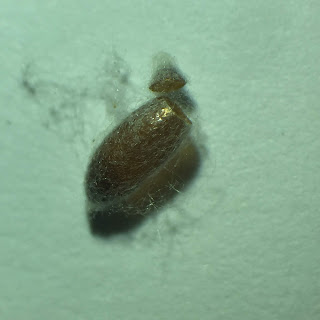Litinsects #19: Metamorphosis, Part 1: Holometabola
Who would like to join me on this 3-part adventure of insect metamorphosis? It is my hope that by the end, you will be TRANSFORMED... into a person who knows a lot more about insect metamorphosis than when you started! 😁
So here goes METAMORPHOSIS PART 1:
Everyone knows that a caterpillar 🐛 makes a cocoon and emerges as a butterfly 🦋,
right? This is an example of COMPLETE METAMORPHOSIS (as opposed to
incomplete which I will go over tomorrow). Butterflies, and a whole lot
of other insects, are HOLOMETABOLOUS (holo = whole/entire, metabola =
change), so called because the insect undergoes drastic changes in body
layout and function and each stage is completely different in appearance
from the others. This includes 4 life stages: egg, larva, pupa, and
adult.
1) All insect lives begin with an EGG. Most hatch within a few days after being laid
2) From the egg emerges a LARVA. Some have legs, some do not, but larvae NEVER HAVE WINGS. They have simple eyes and are usually soft-bodied. Basically, a larva’s job is to eat, grow, and gather energy for metamorphosis
3) Next, a larva metamorphoses into a PUPA, which is a non-feeding, non-locomotive stage (usually in some type of cocoon or casing). It is here that that body undergoes drastic physical changes
4) Finally, the ADULT emerges. The main focus for adults is REPRODUCTION and DISPERSAL. Adult insects possess reproductive organs and the vast majority have wings (unless it is a secondarily wingless species) in order to disperse and find mates.
Holometabolous insects include butterflies, bees, moths, beetles, ants, and flies. Since these are the top groups when it comes to species numbers, holometabolous insects make up a HUGE percentage (probably up to 80%) of insect species.
Some groups even have their own names for larval phases. Did you know caterpillars, grubs, and maggots are just the larval stages of butterflies/moths, beetles, and flies, respectively, not separate kinds of insects?
These pictures are the larva, pupal casing, and adult stage of an Indian meal moth, which unfortunately I saw a lot of in my kitchen a few months ago because they had gotten in to a bunch of stored food containers.
Tomorrow’s post will go into the other two kinds of metamorphosis, HEMIMETABOLOUS and AMETABOLOUS
1) All insect lives begin with an EGG. Most hatch within a few days after being laid
2) From the egg emerges a LARVA. Some have legs, some do not, but larvae NEVER HAVE WINGS. They have simple eyes and are usually soft-bodied. Basically, a larva’s job is to eat, grow, and gather energy for metamorphosis
3) Next, a larva metamorphoses into a PUPA, which is a non-feeding, non-locomotive stage (usually in some type of cocoon or casing). It is here that that body undergoes drastic physical changes
4) Finally, the ADULT emerges. The main focus for adults is REPRODUCTION and DISPERSAL. Adult insects possess reproductive organs and the vast majority have wings (unless it is a secondarily wingless species) in order to disperse and find mates.
Holometabolous insects include butterflies, bees, moths, beetles, ants, and flies. Since these are the top groups when it comes to species numbers, holometabolous insects make up a HUGE percentage (probably up to 80%) of insect species.
Some groups even have their own names for larval phases. Did you know caterpillars, grubs, and maggots are just the larval stages of butterflies/moths, beetles, and flies, respectively, not separate kinds of insects?
These pictures are the larva, pupal casing, and adult stage of an Indian meal moth, which unfortunately I saw a lot of in my kitchen a few months ago because they had gotten in to a bunch of stored food containers.
Tomorrow’s post will go into the other two kinds of metamorphosis, HEMIMETABOLOUS and AMETABOLOUS



Comments
Post a Comment